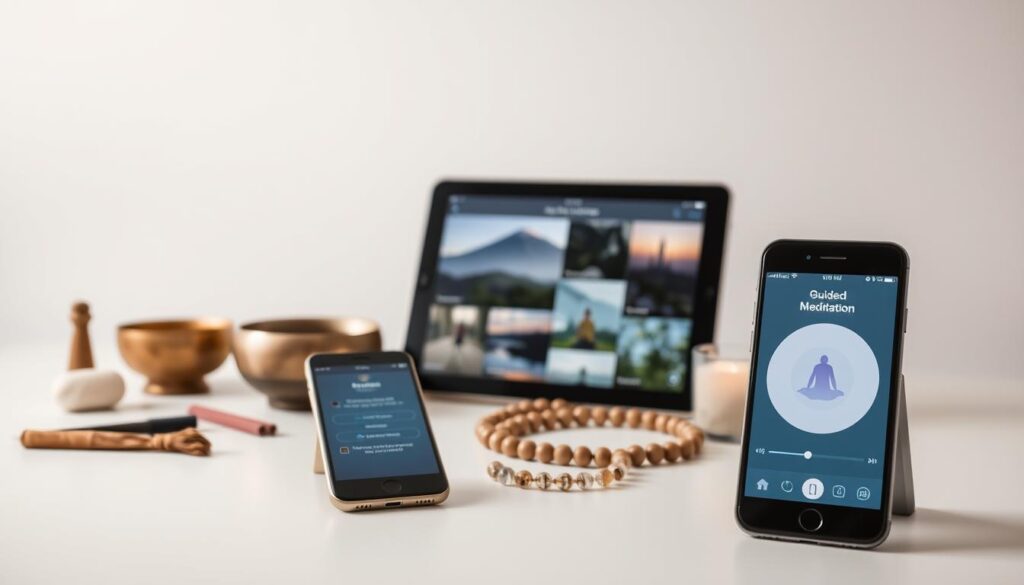Jumpstart Your Meditation Journey: A Step-by-Step Guide

Ever feel like daily life is too much to handle? Meditation can be your calm in the storm. Imagine a quiet moment each day where your thoughts slow down, your breathing gets deeper, and stress disappears. That’s what meditation for beginners can offer.
Maybe you’ve thought about starting a meditation practice but didn’t know where to start. This guide is here to help. It’s not about being perfect—it’s about taking small steps towards peace.
Key Takeaways
- A structured guide breaks down meditation into simple, actionable steps.
- Learn how to start a meditation practice tailored to your lifestyle.
- Discover the science-backed benefits of mindfulness and relaxation.
- Explore tools and techniques to stay consistent, even on tough days.
- Access expert tips for creating a personalized routine that works for you.
Understanding Meditation and Its Benefits
Meditation helps you focus and calm your thoughts. It doesn’t need silence or being perfectly calm. It’s about gently bringing your attention back to now. Let’s explore how this simple act can change your life.
What is Meditation?
Meditation is about training your mind to stay in the present. You might pay attention to your breath, a sound, or something you see. It’s okay if your mind drifts off. The key is noticing and refocusing.
Physical and Mental Benefits
- Benefits of meditation include lower blood pressure and less anxiety.
- It can help with stress, ease headaches, and improve sleep.
- Studies show it boosts focus and emotional strength over time.
Debunking Common Myths
“You have to clear your mind completely.” False. Thoughts will arise—this is normal.
Meditation isn’t about being perfect. Even a few minutes a day is beneficial. You don’t need to change your beliefs to try it. Just start small, and let the benefits of meditation grow naturally.
Preparing for Your Meditation Practice
Starting a meditation habit is about making small, thoughtful choices. These meditation tips make it easier to begin and keep going. A little preparation helps you concentrate on your mind and breath.
“A quiet space isn’t about perfection—it’s about presence.” – Sharon Salzberg, meditation teacher
Choose a quiet spot in your home for meditation. It doesn’t have to be large, just free from distractions. A corner with a cushion or chair is ideal. Soft blankets or dim lighting can enhance relaxation.
Finding Your Ideal Time
When can you find a few minutes for peace? Try these options:
- Wake up 10 minutes early to meditate before the day gets busy.
- Evenings are great for unwinding after work.
- Find a time that works for you and stick to it.
Essential Tools
You don’t need much to start. Here are the basics:
- Comfortable seating (floor cushion, chair, or bench)
- Phone timer or app like Insight Timer or Calm
- Optional: soft music or ambient sounds
Focus on what helps you sit calmly, not what’s missing. The aim is to make how to start a meditation practice feel natural. Small steps help you keep going.
Types of Meditation to Explore
Discovering the right meditation techniques is like finding a key that unlocks your personal practice. Start by exploring these approaches tailored for beginners:
“Mindfulness meditation reduces stress by focusing on the present moment.” – Harvard Health Publishing
Mindfulness Meditation
This practice trains you to observe thoughts without judgment. Sit comfortably, focus on your breath, and gently return attention to the present when distracted. Studies show it lowers anxiety and boosts focus. Try apps like Headspace for structured sessions.
Guided Meditation
Follow an instructor’s voice in guided meditation sessions. Platforms like Insight Timer offer free guides to help you stay on track. Perfect for beginners, it reduces self-doubt and provides clear direction.
Loving-Kindness Meditation
Cultivate compassion by repeating phrases like “may I be safe, may I be happy.” This practice fosters emotional resilience and strengthens relationships. Research links it to lower feelings of loneliness.
Experiment with these methods to see what resonates. Mix and match techniques or combine them with your daily routine. Your journey is unique—let curiosity guide your choices.
Creating a Dedicated Meditation Space
Having a special spot for meditation can really help. Even a small corner can become your own retreat. It tells your brain it’s time to focus. Your space doesn’t have to be big—it just needs to feel welcoming. Follow these tips to create a space that supports your meditation. 
Identifying a Calming Environment
“A quiet space helps quiet the mind.” – Mindful Living Journal
Choose a quiet area, like a bedroom corner or a spare room. Soft lighting, like string lights or candles, adds to the calm. Use blinds or curtains to control light and block out sounds.
Essential Items for Your Space
- A cushion, chair, or bench for sitting comfortably
- Plants to purify air and add life to the space
- A small altar or shelf for tools like incense or a timer
Personalizing Your Space
Include things that inspire you. Hang a mantra or quote, or display nature photos. Crystals, seashells, or art can make it uniquely yours. These touches turn your space into a sanctuary, welcoming you each time you meditate.
Developing a Consistent Schedule
Creating a regular meditation routine makes mindfulness a natural part of your life. Start with just five minutes a day. This small step helps you make progress without feeling overwhelmed.
“Consistency beats intensity. A short daily session is better than a perfect one skipped.”
Choosing a Time that Works for You
Find times when you’re least likely to get distracted. Meditating in the morning can set a calm tone for the day. Taking a break in the afternoon can recharge your focus. Evening meditation can help ease stress before bed.
Try different times to see what works best for you.
Setting Reminders and Goals
Use alarms or calendar alerts to remind you of your meditation time. Link it to your daily routines, like after waking up or before brushing your teeth. Be flexible with your timing to stay consistent.
- Start with 5 minutes daily
- Link meditation to existing habits (e.g., after morning coffee)
- Set weekly goals, like meditating 4 days a week
Tracking Your Progress
Keep a journal or use apps like Headspace or Calm to track your sessions. Writing down how you feel after meditating connects your practice to your daily well-being. Celebrate your streaks and adjust as needed.
Techniques for Beginners
Starting meditation can seem daunting, but these three techniques make it easy. They help you focus and calm down, perfect for those new to meditation.
1. Focused Breathing
Start with focused breathing, a key meditation technique. Sit comfortably, close your eyes, and watch your breath. If your mind wanders, gently bring it back to your breath. This improves focus and lowers stress.
Challenge: A wandering mind? Pause and reset—this is normal!
2. Body Scan Meditation
Body scan meditation takes you from toes to head. Lie down, relax, and focus on each part of your body. Release tension as you go. This method boosts physical awareness and relieves muscle tightness.
Tip: Use a timer to stay on track—start with 5 minutes and grow gradually.
3. Visualization Techniques
Visualization lets you create mental images of peaceful places like beaches or forests. Imagine the sounds and smells to get fully immersed. This technique reduces anxiety and boosts creativity.
| Technique | Key Steps | Benefits |
|---|---|---|
| Focused Breathing | Observe breath; return focus when distracted | Reduces stress, improves concentration |
| Body Scan | Progressively scan body from feet to head | Relieves tension, boosts body awareness |
| Visualization | Create vivid mental images of peaceful settings | Lowers anxiety, enhances creativity |
Try out these techniques to see which one works best for you. Remember, it’s about consistency, not perfection. Spend a few minutes each day to see how you progress.
Overcoming Common Challenges
Learning to meditate isn’t always easy. Even experienced meditators face challenges like distractions or feeling restless. Here are some meditation tips to help you stay patient and focused.
Dealing with Distractions
External noises or racing thoughts don’t mean you’re failing. Try these solutions:
- Mental noting: Silently label distractions (“noise,” “planning”) to acknowledge them without attachment.
- Anchor your focus: Return to your breath or a mantra repeatedly. Consistency matters more than perfection.
Managing Restlessness
Sitting quietly feels impossible? Adjust your approach:
- Experiment with postures—use cushions or chairs for comfort.
- Incorporate movement: Try walking meditation or yoga stretches to release tension.
- Shorten sessions: Start with 5-10 minutes if longer sits feel overwhelming.
Handling Emotional Responses
Strong feelings like anxiety or sadness may arise during practice. Use these steps:
“Emotions are temporary waves, not permanent storms.”
Approach them with curiosity, not judgment. Write in a journal afterward to process your thoughts. Pair this with meditation for stress relief to build resilience.
| Challenge | Solution |
|---|---|
| Distractions | Mental noting, anchor focus |
| Restlessness | Posture adjustments, movement |
| Emotional waves | Non-judgmental observation, journaling |
Remember: Progress isn’t linear. Every challenge is a chance to refine your practice. Celebrate small wins to stay motivated!
Utilizing Apps and Resources
Modern meditation resources make it easier than ever to stay consistent. Let’s explore tools that turn your screen into a calm companion.

Popular Meditation Apps
Try these top-rated apps to simplify your routine:
| App | Features | Price |
|---|---|---|
| Headspace | Guided sessions for stress, sleep, and focus | Subscription-based |
| Calm | Nature sounds, sleep stories, and courses | Free tier + premium |
| Insight Timer | Free guided meditations and community | Ad-supported |
Online Guided Sessions
Access live or pre-recorded guided meditation sessions on these platforms:
- YouTube channels like “The Honest Guys” and “Meditation Minis”
- Virtual classes via platforms like Glo or Gaia
“Guided sessions help beginners stay focused and reduce self-doubt.” – Mindful.org
Books and Other Media
Expand your knowledge with these picks:
- Wherever You Go, There You Are by Jon Kabat-Zinn
- Podcasts like “The Daily Meditation Podcast”
Pair these tools with your practice to build confidence. Let them support—not replace—your inner calm.
Joining a Community or Group
Building a meditation habit is easier with friends. Groups offer support and insights that meditation for beginners need. Let’s see how groups help us grow.
Benefits of Group Meditation
- Shared energy boosts focus through what scientists call “social facilitation.”
- Discussing challenges with peers offers fresh solutions.
- Structured sessions reduce the pressure of creating routines alone.
How to Find Local Groups
Start locally with these options:
- Check community centers like YMCA or library events.
- Visit yoga studios advertising group sessions (e.g., CorePower Yoga classes).
- Ask local mindfulness centers or spiritual organizations.
Online Meditation Communities
Virtual options are great for everyone. Check out these meditation resources:
- Insight Timer’s live group sessions.
- Reddit’s r/Meditation forum for peer support.
- Zoom-based groups like the Mindful Living Collective.
“Group practice doubles retention rates for new meditators.” — Harvard Medical School mindfulness study
Balance your routine by mixing weekly group sessions with solo practice. Communities aren’t just for group time. They help deepen your understanding and keep you consistent.
Continuing Your Meditation Journey
As you make meditation a regular part of your life, it’s time to grow further. This section will help you keep up the good work and explore new ways to meditate.
Setting Long-Term Goals
Think about what you want to achieve, like being more patient or understanding yourself better. Write down your goals and check them every week. Change them as needed to match your growth.
Exploring Advanced Techniques
Try more complex methods like body scans or focusing on your breath. Use apps like Calm or Insight Timer for guided sessions. Trying different techniques helps you find what works best for you.
Incorporating Meditation into Daily Life
Meditation isn’t just for quiet times. You can be mindful while eating, listening, or even at work. These moments can bring calm and clarity into your daily life.




